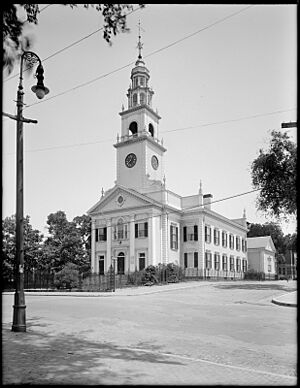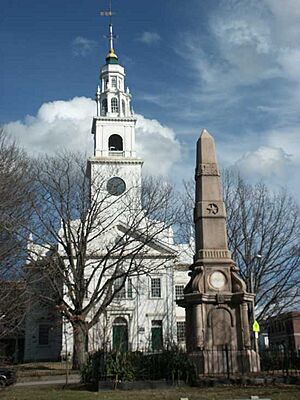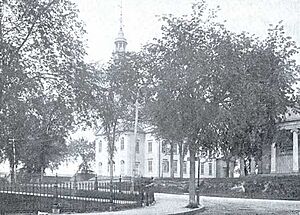First Parish Church of Dorchester facts for kids
Quick facts for kids First Parish Dorchester |
|
|---|---|
| First Parish Church of Dorchester | |
 |
|
| 42°18′29″N 71°03′43″W / 42.3081°N 71.0620°W | |
| Location | Meeting House Hill |
| Country | United States |
| Denomination | Unitarian Universalist |
| Previous denomination | |
| Website | Church website |
| History | |
| Founded | 1630 |
| Dedicated | May 1897 |
| Architecture | |
| Architect(s) | Arthur Greene Everett and Samuel W. Mead |
| Style | Colonial Revival |
| Years built | 1897 |

First Parish Dorchester is a Unitarian Universalist church located in Dorchester, Massachusetts. It was started by English Puritans in 1630. These Puritans wanted to change the Church of England, not leave it completely. However, life in England became very difficult for them.
With encouragement from Reverend John White, they decided to move to New England. On March 20, 1630, they sailed from Plymouth, England, on a ship called the Mary and John. Before they left, the group wrote down their church agreement. Most of the 140 passengers came from the West Country areas of Somerset, Dorset, and Devon.
In late May, the ship first landed in what is now Hull, Massachusetts. Then, in June, they arrived at a place the local Massachusett and Wampanoag people called "Mattapan." The Puritans named their new home "Dorchester Plantation."
Over many years, the church's beliefs changed. It started with Calvinist Puritan ideas, then became Congregational, and later Unitarian around 1816. In 1961, the American Unitarian Association joined with the Universalist Church of America. This created the Unitarian Universalist Association, which led to the modern faith of Unitarian Universalism.
The very first church building was a simple log cabin with a grass roof. Beyond the church, the Puritans also started the first elementary school in the American colonies. This school was supported by public money. They also held the first Town Meeting at the church, which was also called a Meetinghouse. Here, people discussed and decided on important community rules. The fifth church building burned down in February 1896. The building you see today was finished in 1897.
By spring 2015, First Parish had finished the third part of a big restoration project. This project started in November 2006 and cost $7 million. The most recent work included making the building easier to access, fixing and painting the outside, and repairing the steeple. Future plans include updating the Parish Hall and adding more space for community events, classrooms, and activities.
Contents
How First Parish Helps the Community
The church has always been a very important place for social and political life in Dorchester.
Starting the First Public School
The original Puritan group is famous for creating the country's first free public school in 1636. This school was supported by taxes.
Early Steps for Equality
In 1641, a woman named Dorcas ye blackmore, who worked for Israel Stoughton, became the first recorded African American to join a church in New England. She taught Stoughton's Native American workers about the gospel. The church also tried to help Dorcas become free.
A Place for Important Discussions
The first four church buildings also served as Dorchester’s town hall. The fifth building, built in 1816, welcomed many social justice leaders. These included William Lloyd Garrison and Theodore Parker. This was because First Parish's minister, Reverend Nathaniel Hall, strongly supported the movement to end slavery.
Helping Local Children
In the 1880s, the work of First Parish’s minister, Christopher R. Eliot, and Reverend T.J. Volentine from Fields Corner Congregational Church, inspired people to create the Fields Corner Industrial School for local children. This school later became Dorchester House, which is now a health center offering many services.
Supporting Today's Community
Today, First Parish is a valuable resource for many different groups in Dorchester. This includes Vietnamese, African-American, Caribbean, Irish, Latino, Haitian, and Cape Verdean residents. The church staff works with teachers, healthcare providers, and other local groups. They help fight hunger, violence, racism, and other problems caused by poverty.
Important People from First Parish Dorchester
Over its nearly 400-year history, many people connected to First Parish have made a lasting difference in their communities.
Ministers of First Parish
Here are some of the ministers who have served First Parish and when they were there:
- Rev. Elizabeth A. Carrier-Ladd (2020 – 2024)
- Rev. Terry L. Sweetser (interim, 2019 – 2020)
- Rev. Patricia Brennan (interim, 2016 – 2019)
- Rev. Arthur R. Lavoie (2005 – 2015)
- Rev. Victor H. Carpenter (interim, 2003 – 2005)
- Rev. David W. Thompson (interim, 2001 – 2002)
- Rev. Shuma Chakravarty (1998 – 2000)
- Rev. Kenneth R. Warren (interim, 1996 – 1998)
- Rev. Elizabeth Ruth Curtiss (1994 – 1996)
- Rev. David W. Thompson (1991 – 1994)
- Rev. James Kenneth Allen (1954 – 1991)
- Rev. Robert MacPherson (1951 – 1954)
- Rev. Lyman Vincent Rutledge (interim, 1950 – 1951)
- Rev. David Bruce Parker (1950)
- Rev. Robert Arthur Storer (1937 as Junior Minister; 1938 – 1950)
- Rev. Lyman Vincent Rutledge (1921 – 1927)
- Rev. Adelbert Lathrop Hudson (1921 – 1938)
- Rev. Harry Foster Burns (1918 – 1921)
- Rev. Roger S. Forbes (1908 – 1917)
- Rev. Eugene R. Shippen (1894 – 1907)
- Rev. Christopher R. Eliot (1882 – 1893)
- Rev. Samuel J. Barrows (1876 – 1880)
- Rev. Nathaniel Hall (1835 – 1875)
- Rev. Thaddeus Mason Harris (1793 – 1836)
- Rev. Moses Everett (1774 – 1793)
- Rev. Jonathan Bowman (1729 – 1773)
- Rev. John Danforth (1682 – 1730)
- Rev. Josiah Flint (1671 – 1680)
- Rev. Richard Mather (1636 – 1669)
- Rev. John Maverick (1630 – 1635)
- Rev. John Wareham (1630 – 1635)
Other Important Leaders
Some other notable historic leaders from the church include:
- Caroline S. Callendar, who helped start the Fields Corner Industrial School (later Dorchester House).
- Abigail Adams Eliot, a pioneer in the nursery school movement.
- Emily A. Fifield, the second woman elected to the School Committee.
The Meetinghouse Building
The building used today is the sixth meetinghouse built by the church since 1630. It is the fifth building to stand in this exact spot on Meetinghouse Hill since 1673. This building is the only one in Boston that shows the Colonial Revival style for a church, designed to look like a traditional wooden New England meetinghouse.
Rebuilding After the Fire
When the fifth building burned down in February 1896, church members voted just 11 days later. They decided that "a meeting-house be built substantially upon the lines as to the exterior as it was before." This meant they wanted the new building to look very much like the old one from the outside.
On the day the sixth building was dedicated in May 1897, the head of the building committee explained their choice. He said the vote showed what not only their members wanted, but also many others. These people had ancestors who were part of the old meetinghouse or its earlier versions. He added that they wanted to keep the good parts of the old colonial style. This would continue the ideas that came with the ship 'Mary & John' in 1630.
Many descendants of the original Puritans still lived in Dorchester and were members of First Parish. These people likely influenced the decision to make the new building look like the traditional old one. However, the members also wanted to be modern. They soon voted to tear down a smaller building that survived the fire. This allowed them to create a larger Parish Hall. In 1913, they expanded the building again to add a stage. This was to host activities that would attract younger people and help the church grow. The new building was designed to hold many people for different activities. Church notes often show that they cared about serving the community's social, spiritual, and economic needs.
Architects and Design
The original architects were from a Boston firm called Cabot, Everett & Mead. This firm designed buildings for important people and groups. Arthur Greene Everett and Samuel W. Mead joined the firm in 1885. They had worked for Edward Clarke Cabot, who was famous for designing the Boston Athenaeum.
After Cabot retired in 1888, Everett and Mead designed a large home in Nova Scotia for Alexander Graham Bell. This was four years before they worked on First Parish. Everett was from Boston and had trained with a famous New York City architecture firm. Mead and Everett also had connections to the Massachusetts Institute of Technology (MIT)'s architecture department. Mead taught classes there, and Everett was a graduate. Mead had also traveled and studied in Europe. For a church with such a strong connection to Boston's history, these architects' backgrounds were very important. Their design helped the church create a building that looked almost exactly like the fifth one.
Later Changes and Preservation
Other important Boston architects, also linked to MIT, made a few changes to the site. In 1909, Mr. Everett worked with Arthur Asahel Shurtleff to design the landscape. This included the cast-iron fence and memorial gates you see today. Shurtleff, an MIT engineering graduate, had helped start the first four-year landscape architecture program at Harvard University.
In 1913, architect Edwin J. Lewis Jr. oversaw changes to the Parish Hall. These changes created more meeting and entertainment spaces for the church and community. Frank Chouteau Brown, a fellow Boston architect, praised Lewis in 1907 as one of the best architects in suburban Boston. Lewis was also an MIT architecture graduate and a member of First Parish. He provided his services at a lower cost for these projects and even donated the organ chimes in 1925. Lewis designed many large family homes in wealthier parts of Dorchester.
The current church members are very aware of their history. They signed an agreement with the Massachusetts Historical Commission. This agreement helps make sure that their efforts to preserve the building are protected. It also ensures that any future changes will respect the building's history while still serving the community.


